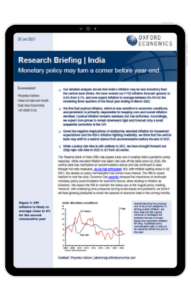India | Monetary policy may turn a corner before year-end

The Reserve Bank of India (RBI) has played a key role in leading India’s pandemic policy response. While elevated inflation has taken rate cuts off the table since Q2 2020, the central bank has maintained an accommodative stance and has continued to ease through non-rate measures, as we had anticipated. But, with inflation spiking anew in Q2 2021, the debate on policy normalisation has turned more intense.
What you will learn:
- Our detailed analysis shows that India’s inflation may be less transitory than the central bank thinks. We have revised our FY22 inflation forecast upward, to 5.6% from 5.1%, and now expect inflation to average between 5%-6% for the remaining three quarters of the fiscal year ending in March 2022.
- We find that acylical inflation, which is less sensitive to economic conditions, and persistent, is primarily responsible for keeping core and overall inflation elevated. Cyclical inflation remains subdued, but has bottomed. Accordingly, we expect core prices to remain downward rigid and forecast only a small sequential correction in the CPI.
- Given the negative implications of stubbornly elevated inflation for household expectations and the RBI’s inflation fighting credibility, we think that the central bank may shift to a neutral stance from accommodative before the end of 2021.
- While a policy rate hike is still unlikely in 2021, we have brought forward our 25bp repo rate hike in 2022 to Q1 from Q3 earlier.
Tags:
Related Services

Post
US Key Themes 2026: Exceptionalism amid fragmentation
US exceptionalism is alive and well, and that won't change in 2026.
Find Out More
Post
Global Key themes 2026: Bullish on US despite AI bubble fears
We anticipate another year of broadly steady and unexceptional global GDP growth, but with some more interesting stories running below the surface.
Find Out More